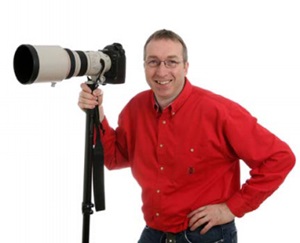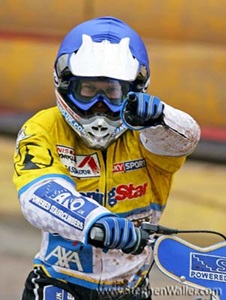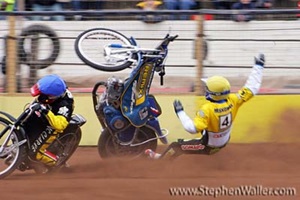
| Home | Contact Us | Articles |
| Books - DVDs | Stadia Pix | Programme Generator |
An Interview With...Stephen Waller
We find out more about the Ipswich track photographer and his new book - "Ipswich Speedway: A Decade in Pictures"
 |
| Stephen Waller |
You've been photographer at Ipswich now for eleven seasons, how did you come to get involved in the first place?
It's been a couple of years longer than that as I actually started photographing speedway regularly at Ipswich in 1995. Prior to that I had attended a couple of press days but was essentially just a supporter on the terraces. Photography was really just a serious hobby, although I had ideas to expand it into a career and saw speedway as a way of giving me a regular subject to work with. I sent Mike Western, who was co promoter at the time, a few pictures that I had taken at the 1995 press day, together with a letter requesting centre green access for a meeting and he agreed and I have been a permanent fixture since!
Didn't the club nearly fold in 1996?
Yes, ironically that ended up helping me although I didn't realise it at the time. I was devastated when the news broke that the club were struggling financially and were ready to pull the plug and shut the gates at Foxhall. I had been going since I was about 5 years old, had just become more closely involved and suddenly it looked like being all over!
So how did this help you?
A big SOS campaign with the Evening Star as one of the main publicists was launched and after lots of fund raising, auctions, pledges of support etc, the club was saved. The one main thing that became apparent during that campaign was that although there were maybe only a couple of thousand regulars going through the turnstiles for each meeting it was estimated that another 20,000 followed the clubs fortunes through the media. The Evening Star announced that because of this they were going to give the club increased coverage from the following season, which presented me with an ideal opportunity.
Their coverage had always been good but the away fixtures lacked live pictures as they only ever used stock images.
I contacted them ahead of the 2006 season to see whether they would be interested in taking my pictures from the away fixtures and following a meeting with the then picture editor, Dave Kindred, they agreed. Initially it was only for the away meetings, with the papers staff photographers still covering the home meetings, unless I managed to capture something more worthy of publication, like a spectacular crash. Things stayed that way for a year or two before I was asked to provide the pictures from the home meetings as well.
 |
| Kim Jansson stares into Stephen's camera |
How do you think the photographers job differs from that in other sports?
All sports require a unique technique and speedway is no different. However, with a lot of sports the action can be predictable whereas with speedway things can go very wrong in a fraction of a second, so you always have to be ready for the unexpected. I've been told on more than one occasion that I have been lucky to get some of the pictures that I have, but I guess over time an instinct is formed and it becomes second nature to anticipate a shot, plus it helps to know the sport. Of course there is always an element of luck involved; although I aspire to the principle of the harder you practice the luckier you tend to become!
Are there any particular joys or frustrations involved with the job?
Sure, the joys are when you get a picture or sequence that you know is going to get people talking, or you drive past a newsagents the day after a meeting and see an advertising poster outside saying something like amazing speedway crash sequence today!
Frustrations include missing out on a shot that you would have been well placed to capture had you not moved a few moments before.
How has the job changed since you started in 1995?
Digital equipment has changed the job enormously. I remember when I started I was shooting on film. During a meeting I would get through a couple of rolls and on the way home I would have to detour to Lower Brook Street, Ipswich, to post my film through the letterbox of the Evening Star offices. Whoever was on the early shift would then develop the film when they arrived and would scan the images for that afternoon's paper. You often had an idea of what you had captured but never really knew until looking in the paper the following day.
When digital first arrived it allowed me to download the images myself when I got back after a meeting and email them to the paper and this soon progressed to carrying a laptop with me to download, caption and transmit images, via a mobile phone, from the track. It's now pretty usual to send a couple of images for the next morning's East Anglian Daily times newspaper before 9pm, which can sometimes be difficult if it is raining, if you can't get a signal to connect, or if you are trying to make notes when you also have a report to do!
How did the idea for the book come about?
Dave Kindred, who as I mentioned was the picture editor at the paper when I started, had done a couple of historical photo books with the publishers AtHeart and they were looking to do another title with him on a different subject. Dave put the idea forward to do a speedway book, as he had covered the sport himself when the club reopened under John Berry in the late sixties. As the idea progressed Dave decided that the more recent times were probably more relevant and kindly passed the whole project over to me, although he was still involved in an advisory capacity.
 |
| Stephen captures a Robert Miskowiak fall |
How did you go about selecting the pictures to be included?
From my first meeting I have invested hundreds of hours captioning and cataloguing my images and have a fairly extensive library stored digitally. It was therefore fairly easy to go through the years copying anything that jumped out and was relevant into a shortlist folder. Originally the book was going to feature around 200 images, so I selected about 250 to choose from. However, when I started to layout the images onto the pages it soon became apparent that I would need more, so I had to go back into the archive and select another hundred or so to give me the choice. Picking images that went well with each other, or worked on the pages was the difficult bit. I had more than a few very late evenings/early mornings moving things around to fit.
What are your hopes for the book?
To be successful, which I guess means selling enough copies to make a profit. I also hope that it helps to increase the profile of the team in some way. I believe that no other club has ever had a book like this produced, so it is a bit of a first.
Has the club been supportive towards the book?
Yes it seems to have been well received and Chris & Julie Louis in particular have been very supportive of the project and my photography in general.
Are we likely to see any more books from you?
Well there was a great deal more work in putting it together than I anticipated but I was pleased with the result and quite enjoyed working on it, so I certainly wouldn't rule out doing another. Ultimately though it's the supporters who will decide whether it's something they want to see more of I guess.
This article was first published on 29th May 2008